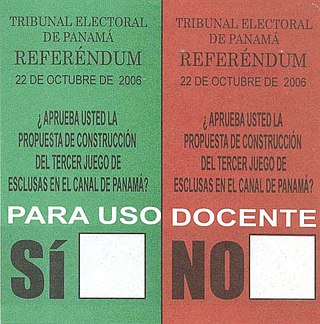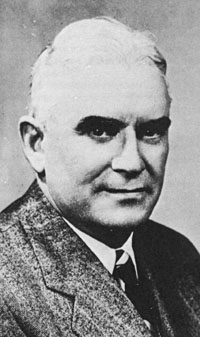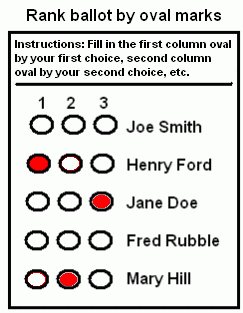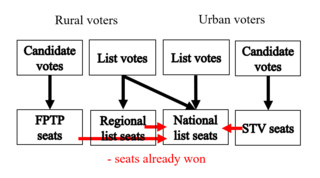Related Research Articles

Proportional representation (PR) refers to any type of electoral system under which subgroups of an electorate are reflected proportionately in the elected body. The concept applies mainly to political divisions among voters. The essence of such systems is that all votes cast – or almost all votes cast – contribute to the result and are effectively used to help elect someone. Under other election systems, a bare plurality or a scant majority are all that are used to elect candidates. PR systems provide balanced representation to different factions, reflecting how votes are cast.

The single transferable vote (STV) or proportional-ranked choice voting (P-RCV), is a multi-winner electoral system in which each voter casts a single vote in the form of a ranked ballot. Voters have the option to rank candidates, and their vote may be transferred according to alternative preferences if their preferred candidate is eliminated or elected with surplus votes, so that their vote is used to elect someone they prefer over others in the running. STV aims to approach proportional representation based on votes cast in the district where it is used, so that each vote is worth about the same as another.

Single non-transferable vote or SNTV is an electoral system used to elect multiple winners. It is a semi-proportional variant of first-past-the-post voting, applied to multi-member districts where each voter casts just one vote. It can also be seen as a variant of STV but with no vote transfers.

Voting refers to the process of choosing officials or policies by casting a ballot, a document used by people to formally express their preferences. Republics and representative democracies are governments where the population chooses representatives by voting.

Electoral reform in New Zealand has been a political issue in the past as major changes have been made to both parliamentary and local government electoral systems.
The Citizens' Assembly on Electoral Reform was created by the government of British Columbia, Canada to investigate changes to the provincial electoral system. On October 25, 2004, the citizens' assembly proposed replacing the province's existing first past the post (FPTP) system with BC-STV, a single transferable vote (STV) system. This recommendation was put to the electorate in a referendum in 2005 held during that year's provincial election. The provincial government required the referendum to achieve a super-majority of 60 percent of voters and simple majorities in 60 percent of the 79 districts in order to pass. The second of these thresholds was easily met, with a majority supporting the reform in 77 out of 79 electoral districts, but the overall vote fell short of the 60 percent requirement, with 57.69 percent of the votes in favour. A second referendum in 2009 on adopting the STV system also failed to pass carrying 8 electoral districts and 39.09 percent of the overall vote.

A referendum was held in the Canadian province of British Columbia on May 17, 2005, to determine whether or not to adopt the recommendation of the Citizens' Assembly on Electoral Reform to replace the existing first-past-the-post electoral system (FPTP) with a single transferable vote system (BC-STV). It was held in conjunction with the BC Legislative Assembly election of 2005. Voters were given two ballots at that time: a ballot to vote for a Member of the Legislative Assembly of British Columbia (MLA) in their constituency and a referendum ballot. The referendum received considerable support from the electorate but failed in meeting the 60-percent threshold that had been set. A second referendum was held in 2009.

The 1952 British Columbia general election was the 23rd general election in the Canadian province of British Columbia. It was held to elect members of the Legislative Assembly of British Columbia, alongside a plebiscite on daylight saving time and liquor. The election was called on April 10, 1952, and held on June 12, 1952. The new legislature met for the first time on February 3, 1953.
The Edmonton provincial electoral district also known as Edmonton City from 1905 to 1909, was a provincial electoral district in Alberta, Canada mandated to return members to the Legislative Assembly of Alberta from 1905 to 1917 and again from 1921 to 1959.
Historically, the single transferable vote (STV) electoral system has seen a series of relatively modest periods of usage and disusage throughout the world; however, today it is seeing increasing popularity and proposed implementation as a method of proportional representation and a goal of electoral reform. STV has been used in many different local, regional and national electoral systems, as well as in various other types of bodies, around the world.
Instant-runoff voting (IRV) is a ranked voting method used in single-winner elections. IRV is also known outside the US as the alternative vote (AV). Today it is in use at a national level to elect the Australian House of Representatives, the National Parliament of Papua New Guinea, the President of Ireland and President of India. In Australia it is also used for elections to the legislative assemblies of all states and territories except Tasmania and the Australian Capital Territory, and for the Tasmanian Legislative Council.
The Politics of British Columbia involve not only the governance of British Columbia, Canada, and the various political factions that have held or vied for legislative power, but also a number of experiments or attempts at political and electoral reform.

Following the 2005 electoral reform referendum, British Columbia held a second referendum on electoral reform in conjunction with the provincial election on May 12, 2009. As in 2005, voters in 2009 were asked were asked which electoral system should be used to elect legislators: the existing first-past-the-post electoral system or the BC single transferable vote electoral system (BC-STV) proposed by the British Columbia Citizen's Assembly on Electoral Reform to ensure more proportional representation in the provincial Legislative Assembly.
There are a number of complications and issues surrounding the application and use of single transferable vote proportional representation that form the basis of discussions between its advocates and detractors.
Electoral reform is a change in electoral systems which alters how public desires are expressed in election results.

An electoral or voting system is a set of rules used to determine the results of an election. Electoral systems are used in politics to elect governments, while non-political elections may take place in business, non-profit organisations and informal organisations. These rules govern all aspects of the voting process: when elections occur, who is allowed to vote, who can stand as a candidate, how ballots are marked and cast, how the ballots are counted, how votes translate into the election outcome, limits on campaign spending, and other factors that can affect the result. Political electoral systems are defined by constitutions and electoral laws, are typically conducted by election commissions, and can use multiple types of elections for different offices.

Ranked voting is any voting system that uses voters' rankings of candidates to choose a single winner or multiple winners. More formally, a ranked system is one that depends only on which of two candidates is preferred by a voter, and as such does not incorporate any information about intensity of preferences. Ranked voting systems vary dramatically in how preferences are tabulated and counted, which gives them very different properties. In instant-runoff voting (IRV) and the single transferable vote system (STV), lower preferences are used as contingencies and are only applied when all higher-ranked preferences on a ballot have been eliminated or when one of the higher ranked preferences has been elected and surplus votes need to be transferred.

The dual-member mixed proportional (DMP) voting method is a mixed electoral system using a localized list rule to elect two representatives in each district. It is similar to other forms of mixed-member proportional representation but differs in that all representatives are elected locally in small districts, rather than requiring separate list seats to be filled in large regional or nationwide districts. In the first step, one seat in each district is awarded to the candidate with the most votes, as with first-past-the-post voting rules. In the second step, underrepresented parties are assigned secondary seats in the districts in which they won the most votes, which creates an overall proportional result.

A referendum on electoral reform took place by mail-in ballot between October 22 and December 7, 2018, in the Canadian province of British Columbia. 61.3 percent of voters supported maintaining the first-past-the-post voting system rather than switching to a proportional representation voting system, which was supported by 38.7 percent of voters. This was British Columbia's third referendum on electoral reform, following ones in 2005 and 2009.

Rural–urban proportional representation (RUP), also called flexible district PR, is a supermixed electoral system which combines the use of single- and multi-member constituencies in a lower tier and top-up seats in an upper tier to meet the different needs of both rural and urban areas, while protecting the objective of proportionality. The term was coined by Fair Vote Canada, which devised a rural–urban system with the intention of meeting the special challenges of Canada's geography, which includes wide-flung, sparsely populated areas.
References
- ↑ Elections BC: Statement of Votes - Referendum on Electoral Reform - May 17, 2005, page 9
- ↑ More in BC Aware of Voting Referendum [usurped] from Angus Reid Global Monitor : Polls & Research
- ↑ Elections BC (May 12, 2009). Statement of Votes Referendum on Electoral Reform (PDF). p. 20.
- ↑ Ken MacQueen. "BC to Vote on Electoral Reform". Macleans, June 5, 2005.
- ↑ Special Committee on the Citizens' Assembly on Electoral Reform (February 2005). "Final Report, Appendix C: Ballots and Vote Counting Under BC-STV" (PDF). Fifth Session, Thirty-Seventh Parliament.
- ↑ Special Committee on the Citizens' Assembly on Electoral Reform (February 2005). "Final Report, Appendix C: Ballots and Vote Counting Under BC-STV" (PDF). Fifth Session, Thirty-Seventh Parliament, p. 6
- ↑ A Century of Democracy, Centennial Series. pp. 162 (1944 Overseas vote for Army MLA), 426 (2001 Calgary-Cross).
- ↑ Toronto 2014 Ward 16